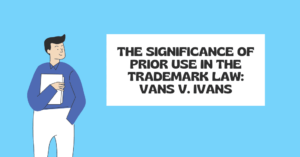In today’s interconnected world, trademarks play a crucial role in differentiating products and services while also functioning as valuable business assets. Among the various types of trademarks, well-known trademarks occupy an exclusive spot. Well-known marks are the marks that have achieved exceptional recognition and reputation, transcending geographic boundaries. India, with its rich trademark jurisprudence, recognizes the significance of well-known trademarks and has put in place legal provisions to ensure their protection. In this article, we will delve into what well-known trademarks are, discuss the legal provisions, and shed light on the filing procedure.
What is a Well- Known Trademark?
A well-known trademark, also known as a “famous trademark,” is a mark that has garnered substantial public recognition and favour. These trademarks are readily distinguishable and are strongly associated with a particular brand or product. They have expanded their influence outside of their respective industries, garnering recognition in a variety of fields. Companies place a high value on their well-known trademarks and afford them extensive legal protection.
Section 2(1)(zg) of the Trademarks Act, 1999 defines “well-known trade mark”, “in relation to any goods or services, means a mark which has become so to the substantial segment of the public which uses such goods or receives such services that the use of such mark in relation to other goods or services would be likely to be taken as indicating a connection in the course of trade or rendering of services between those goods or services and a person using the mark in relation to the first-mentioned goods or services.”
Examples of Famous Trademarks
- Google: As the world’s leading search engine, Google has become synonymous with internet searching. It’s simple and colourful logo is instantly recognizable.
- Nike: The Nike swoosh is an iconic symbol in the sports and apparel industry. Nike’s “Just Do It” slogan is also widely recognized and associated with athleticism.
- Amazon: The smiling arrow from Amazon’s logo represents customer satisfaction. Amazon’s e-commerce platform is used by millions worldwide, and its services extend beyond online shopping.
- Ferrari: The prancing horse emblem of Ferrari is synonymous with luxury sports cars. Ferrari is known for its high-performance vehicles.
Deciding Factors for well-known trademarks
To determine the eligibility of a trademark for well-known status in India under Section 11(6) of the Trademarks Act, 1999, specific criteria must be met:
- The trademark must have achieved a high level of recognition and goodwill among the relevant section of the public, including knowledge in India obtained through promotional efforts.
- The trademark’s use should be substantial and consistent over time, with a wide geographical presence.
- The trademark’s promotional efforts, such as advertising, publicity, and presentations at fairs or exhibitions, should be extensive in scope.
- The duration and geographical area of trademark registration or application for registration under the Act reflect the use and recognition of the trademark.
- A successful record of enforcing the rights associated with the trademark, including recognition as a well-known mark by courts or Registrars, is a crucial factor.
Filing Procedure for Well-Known Trademarks
Rule 124 of the Trademark Rules, 2017, provides the process for filing a well-known trademark in India. This process involves the following steps:
- Filing an application
Any interested party can submit an application online by filling out Form TM-M and attaching the required documents. These documents include a statement supporting the application, detailing the reasons for recognizing the trademark as well-known. The government fees for filing of such application is 1,00,000 Rupees per application.
- Evidence Submission
The applicant has to gather and submit substantial evidence of the trademark’s recognition and reputation, including market surveys, sales figures, advertisements, and media coverage.
- Examination Stage
The Registrar examines the application and evidence to determine if the mark qualifies as well-known, ensuring only marks with genuine recognition are granted this status.
- Publication
Upon recognition, the mark is published in the Trademarks Journal for third-party opposition. If no opposition is filed within the stipulated time, typically four months, the mark is granted the status of a well-known trademark. However, it is important to note that even after the introduction of Rule 124, the courts continue to have the power to decide whether a trademark qualifies as “well-known.”
Case Study: Daimler Benz Aktiegesellschaft & Anr. v. Hybo Hindustan
- Background
In the landmark case of Daimler Benz Aktiegesellschaft & Anr. v. Hybo Hindustan, a critical issue unfolded. An undergarment retailer boldly adopted the term ‘Benz’ in its brand name and introduced a logo eerily resembling the emblem famously associated with the automotive giant, Mercedes-Benz. This emblem, the iconic three-star ring, is celebrated globally for its automotive legacy. Intriguingly, the defendant ventured into the undergarment domain while employing a logo featuring a human figure enclosed within a three-pointed ring. Mercedes-Benz took legal action against the defendant.
- Verdict
The court called the defendant’s actions a trademark infringement. The Mercedes-Benz three-star ring is highly regarded in the automotive industry. The court ruled and stopped the defendant from using the three-star ring and the term “Benz” with undergarments. The judgement was well-known worldwide, showing the strong global reputation of the Mercedes-Benz trademark. It was acknowledged that it is widely known that “Benz” is strongly associated with the automotive industry. The verdict confirmed that using a well-known mark in a different industry is both infringement and an attempt to benefit from its worldwide recognition.
This case stands as a testament to the imperative of safeguarding well-known trademarks on a worldwide scale. It underscores the necessity for robust legal measures to preserve the integrity of well-known marks, preventing unauthorized use that could dilute their reputation and create confusion among consumers worldwide.
Significance of Well-Known Marks
Well-known trademarks have assumed a heightened significance in India’s dynamic business landscape. As the Indian economy continues to grow, both domestic and international brands are vying for consumer attention. In such a competitive environment, well-known marks are invaluable. They not only assure consumers of the quality and authenticity of products and services but also foster brand loyalty.
Additionally, well-known marks have a substantial impact on trademark litigation. The recognition of a mark as “well-known” can significantly strengthen a trademark owner’s position in legal disputes, making it more challenging for infringers to argue that they were unaware of the mark’s reputation.
Conclusion
In India, as in the rest of the world, well-known trademarks hold immense value for both businesses and consumers. They symbolise reliability, quality, and an enduring tradition of excellence. The legal framework of India acknowledges the significance of safeguarding these trademarks, ensuring that they continue to flourish and retain their individuality. The well-considered legal provisions, filing procedure, and trademark rules of 2017 aid in preserving the integrity and reputation of well-known trademarks, thereby fostering innovation and the expansion of national brands.









